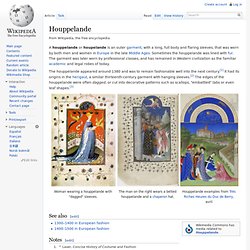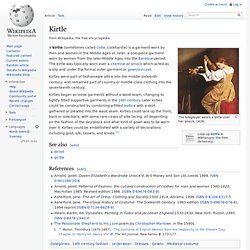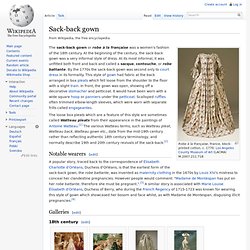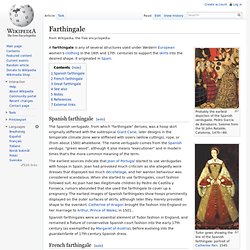

O QUE VESTIAM OS NOSSOS AVÓS. Fashion and Costume History. Houppelande. A houppelande or houpelande is an outer garment, with a long, full body and flaring sleeves, that was worn by both men and women in Europe in the late Middle Ages.

Sometimes the houppelande was lined with fur. The garment was later worn by professional classes, and has remained in Western civilization as the familiar academic and legal robes of today. The houppelande appeared around 1380 and was to remain fashionable well into the next century.[1] It had its origins in the herigaut, a similar thirteenth-century garment with hanging sleeves.[2] The edges of the houppelande were often dagged, or cut into decorative patterns such as scallops, "embattled" tabs or even leaf shapes.[3] Woman wearing a houppelande with "dagged" sleeves. See also[edit] Notes[edit] Jump up ^ Laver, Concise History of Costume and FashionJump up ^ Howell, Lauren. References[edit] Surcoat. The classic knight's surcoat is on the left; the knight on the right has a different style A surcoat, or surcote, was an outer garment commonly worn in the Middle Ages by both men and women.

It can either refer to a coat worn over other garments or the outer garment of a person. Kirtle. The luteplayer wears a kirtle over her smock, 1626.

Kirtles were part of fashionable attire into the middle sixteenth century, and remained part of country or middle-class clothing into the seventeenth century. Kirtles began as loose garments without a waist seam, changing to tightly fitted supportive garments in the 14th century. Later kirtles could be constructed by combining a fitted bodice with a skirt gathered or pleated into the waist seam. Robe à l'anglaise / close-bodied gown. Close-bodied gown or robe à l'anglaise of cotton with floral sprigs embroidered in wool, shown with a quilted silk petticoat and fichu or kerchief, England, 1780s, Los Angeles County Museum of Art, M.59.25a-c.

Gallery[edit] Robe a l'anglaise (closed gown) with matching petticoat, French, 1784-87, Cotton, metal, and silk. Metropolitan Museum of Art, New York, 1991.204a, bSide view of the robe a l'anglaise at the Metropolitan Museum of Art. See also[edit] Notes[edit] Jump up ^ Waugh, Norah (1968). Costume & Fashion Designers: Costume Gallery. Pannier (clothing) Hoop petticoat or pannier, English, 1750-80.

Plain-woven linen and cane. Panniers or side hoops are women's undergarments worn in the 17th and 18th centuries to extend the width of the skirts at the side while leaving the front and back relatively flat. This provided a panel where woven patterns, elaborate decorations and rich embroidery could be displayed and fully appreciated. The style originated in Spanish court dress of the 17th century, familiar in portraits by Velázquez. The fashion spread to France and from there to the rest of Europe after c. 1718–1719, when some Spanish dresses had been displayed in Paris.[1] It is also suggested that the pannier originated in Germany or England, having been around since 1710 in England, and appearing in the French court in the last years of Louis XIV’s reign.[2] Robe à la française / sack-back gown. The loose box pleats which are a feature of this style are sometimes called Watteau pleats from their appearance in the paintings of Antoine Watteau.[1] The various Watteau terms, such as Watteau pleat, Watteau back, Watteau gown etc., date from the mid-19th century rather than reflecting authentic 18th century terminology, and normally describe 19th and 20th century revivals of the sack-back.[2] Notable wearers[edit]

The History of Costume - Index #1. Click On Picture To Enlarge It (100K).

Plate # 1 - Egyptians, Moors, Turks Plate # 2 - Ancient Near East - Assyrian, Persian, Egyptian. Farthingale. Probably the earliest depiction of the Spanish verdugada.

Pedro García de Benabarre, Salome from the St John Retable, Catalonia, 1470—80. Tudor gown showing the line of the Spanish farthingale: portrait of Catherine Parr, 1545. Silhouette of the 1590s: Elizabeth I, the Ditchley portrait A farthingale is any of several structures used under Western European women's clothing in the 16th and 17th. centuries to support the skirts into the desired shape. It originated in Spain. Spanish farthingale[edit] The Spanish vertugado, from which "farthingale" derives, was a hoop skirt originally stiffened with the subtropical Giant Cane; later designs in the temperate climate zone were stiffened with osiers (willow cuttings), rope, or (from about 1580) whalebone.
The earliest sources indicate that Joan of Portugal started to use verdugadas with hoops in Spain. French farthingale[edit] French farthingales, c. 1580. 1700's-1920's Fashions & Accessories. Fashion History Costume Trends & Eras - Haute Couture. Colonial era. Regency era. Middle Ages. Renaissance & Tudor period. Pictures.